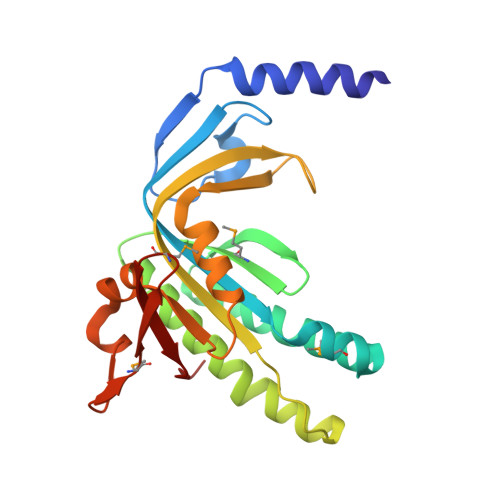Cyclic CMP and cyclic UMP mediate bacterial immunity against phages.
Tal, N., Morehouse, B.R., Millman, A., Stokar-Avihail, A., Avraham, C., Fedorenko, T., Yirmiya, E., Herbst, E., Brandis, A., Mehlman, T., Oppenheimer-Shaanan, Y., Keszei, A.F.A., Shao, S., Amitai, G., Kranzusch, P.J., Sorek, R.(2021) Cell 184: 5728
- PubMed: 34644530
- DOI: https://doi.org/10.1016/j.cell.2021.09.031
- Primary Citation of Related Structures:
7R65 - PubMed Abstract:
The cyclic pyrimidines 3',5'-cyclic cytidine monophosphate (cCMP) and 3',5'-cyclic uridine monophosphate (cUMP) have been reported in multiple organisms and cell types. As opposed to the cyclic nucleotides 3',5'-cyclic adenosine monophosphate (cAMP) and 3',5'-cyclic guanosine monophosphate (cGMP), which are second messenger molecules with well-established regulatory roles across all domains of life, the biological role of cyclic pyrimidines has remained unclear. Here we report that cCMP and cUMP are second messengers functioning in bacterial immunity against viruses. We discovered a family of bacterial pyrimidine cyclase enzymes that specifically synthesize cCMP and cUMP following phage infection and demonstrate that these molecules activate immune effectors that execute an antiviral response. A crystal structure of a uridylate cyclase enzyme from this family explains the molecular mechanism of selectivity for pyrimidines as cyclization substrates. Defense systems encoding pyrimidine cyclases, denoted here Pycsar (pyrimidine cyclase system for antiphage resistance), are widespread in prokaryotes. Our results assign clear biological function to cCMP and cUMP as immunity signaling molecules in bacteria.
Organizational Affiliation:
Department of Molecular Genetics, Weizmann Institute of Science, Rehovot 7610001, Israel.















